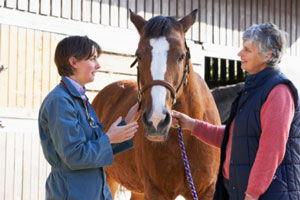What is Animal Chiropractic or Veterinary Chiropractic?

Will your pet benefit from a visit from our chiropractor?
Are they really the same?
Animal chiropractic, also known as veterinary chiropractic is a combination of traditional human chiropractic and veterinary medicine to form a unique profession that has recognition as a separate health care branch.
What qualifications does an animal chiropractor have?
In Britain, membership to the British Veterinary Chiropractic Association (BVCA) is only granted to qualified veterinarians (registered with Royal College of Veterinary Surgeons) or chiropractors (registered with General Chiropractic Council) upon successful completion of approved veterinary chiropractic postgraduate training followed by successful completion of an independent certification examination by International Veterinary Chiropractic Association (IVCA). All members are required to adhere to membership rules and regulations of IVCA and complete 30 hours of continuing professional development courses every three years in order to keep up to date with developments in veterinary chiropractic. Consequently, members offer the best possible treatment to their clients.
Gale Z. (Doctor of Chiropractic) began working with animals over 30 years ago in Canada. She is trained and certified IAVC (International Academy of Veterinary Chiropractic) and is a member of both the International Veterinary Chiropractic Association (IVCA) and BVCA (British Veterinarian Chiropractic Association).
Why does my pet need chiropractic care?
There are many reasons for subluxations to develop in the spinal or peripheral joints of animals. Macro-traumas can be seen and are the slips and trips, the kicks, the strains and sprains, the competitions, mishaps in training or are generated by the activities of a very vigorous animal. Your animal is hurt, and they need help. Read More>>>
For those not familiar with this term, a subluxation is a joint that is not working properly when comparing it to the other joint surfaces or tissues around it and not moving freely or in the normal pattern that it should. It changes the biomechanics of the joint, which can affect the nerve function and affect the muscles around it directly by the injured nerve or because the area hurts. Altered biomechanics in one joint can also cause problems in other joints through compensation because the animal is forced to move differently to lessen the pain or because they are stuck and just cannot move into that range.
You cannot see micro-traumas happen, but they build up in your animal but just as in people. Eventually, you just are not comfortable anymore and now there is a problem that affects you. Our four-legged friends cannot tell you this in words, but you just know something is wrong by knowing and watching them. Animals in their geriatric phase in life are especially susceptible to micro- traumas. We recommend regular check-ups to help prevent the build-up of problems, particularly if you know your animal is regularly exposed to macro-traumas or is in the geriatric phase and susceptible to micro- trauma.
How do you help my pet?
An animal’s spine is a very complex structure. The spinal bones (vertebrae), like beads on a string, are able to move. Even though individual vertebral joints have very little mobility, held by ligaments and muscles, the accumulative flexibility of the spine as a whole is considerable. This flexibility allows a horse or dog to perform at their optimum level and without it, fluent movement is impossible. Read More>>>
From in the skull the brain’s nerve tissue continues as the cord which tunnels through the vertebral bones. The nerve tissue in the spinal cord is the main pathway for information connecting the brain and peripheral nervous system. Nerves branch off from the spinal cord and leave the spinal canal in pairs. These nerve branches (called spinal nerves) leave the spinal canal through small spaces going either to the left or the right side of the animal. These nerves transfer information back and forth between the brain, spinal cord, organs, muscles and every other part of the body.
As the brain and cord (central nervous system) monitor and control all organ and tissue function, the transmission of information to and from it must flow freely to allow proper function. This transmission will take place unless there is a subluxation is present discernible by the evidence of an abnormal movement (too much or too little) or other indicators of a vertebral subluxation complex VSC. Normally the spinal vertebra and ribs serve as the framework of support and attachment for many muscles giving protection to the spinal cord and protection to the internal organs.
Subluxations, when present, do just the opposite and can lead to chronic musculoskeletal problems, acute problems such as tension or stiffness or other seemingly unusual issues when dealing with the far-reaching effect of nerves and nerve function.
Getting chiropractic care for your four-legged family friends to reduce subluxations, offers prophylactic treatment to maintain their fitness, maintains soundness in older animals, will enhance performance ability of sport animals and will give you a happier animal.
Vertebral Subluxation Complexes (VSC)
The American Chiropractic Association (ACA) defines a VSC as “an aberrant relationship between two adjacent articular structures that may have functional or pathology sequence, causing an alteration in the biomechanical and/or neurophysiological reflections of these articular structures, their proximal structures and/or body systems that may be directly or indirectly affected by them.”
Find out more about keeping your pet healthy by contacting our practice today!
![]()


